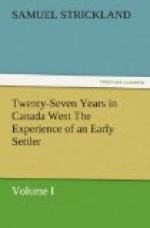CHAPTER XII.
WANT OF HOME-PASTURAGE IN CANADA. — DANGER OF BEING LOST IN THE WOODS. — PLAIN DIRECTIONS TO THE TRAVELLER IN THE BUSH. — STORY OF A SETTLER FROM EMILY. — AN OLD WOMAN’S RAMBLE IN THE WOODS. — ADVENTURE OF A TRAPPER. — FORTUNATE MEETING WITH HIS PARTNER.
One of the greatest inconveniences belonging to a new settlement, for the first four or five years, is the want of pasturage for your working cattle and cows. Consequently, the farmer has to depend entirely on the Bush for their support, for at least seven months out of the twelve. The inconvenience does not arise from any want of food; for the woods, beaver meadows, and the margins of lakes and streams yield an abundance, and the cattle, towards the fall of the year, are sure to grow fat. But it is the trouble of seeking for your cattle.
Sometimes, indeed, in the midst of your greatest hurry, your oxen are nowhere to be found. I have myself often spent two or three days in succession, searching the woods in vain; and it not unfrequently happens that, while looking for the strayed beasts, you lose yourself in the woods.
As we generally carry a gun with us in these excursions, we often fall in with deer or partridges, which makes the way not only seem less fatiguing, but even pleasant, unless during the season of musquitoes and black flies, when rambling through the Bush is no pleasure to any one.
New-comers are very apt to lose themselves at first, until they get acquainted with the creeks and ridges; and even then, on a dark day or during a snow-storm, they are very likely to go astray. If you have no compass with you, and the sun is obscured, the best way of extricating yourself is, to observe the moss on the trees, which—not every one knows—grows more luxuriantly and in greater quantities on the north side of the tree. It is of little use to look at any tree separately: this will perhaps only mislead you; but if you observe the general aspect of the woods around, the indications may be of great service to you. Towards the north, the trunks of the trees will appear light and cheerful, while the south side will look dark and spotted. This plan, however, will only answer amongst hard woods.* [* Deciduous trees are called hard-wood.] The ridges mostly run north-east and south-west, and the swamps parallel with them. Then, again, in pine woods the general inclination of the timber is from the north-west. All these indications have been successfully followed, and should be borne in mind.
People who lose themselves in the Bush seldom persevere long enough in any one direction. They fancy they are going wrong, and keep changing their course; till probably, after four or five hours’ walking, they find themselves near the spot from whence they started. This has occurred to me more than once, and I shall relate a melancholy incident which happened only a few years ago, and which proves what I have just stated.




